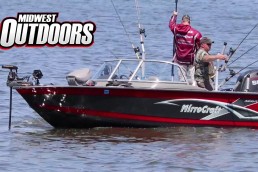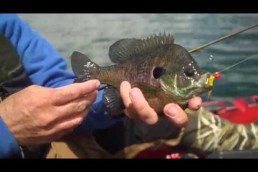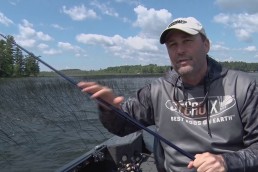A MidWest Outdoors 50th Anniversary Legacy Feature: Lowrance and 60 Years of Innovation in Fishing Electronics
SHARE THIS POST
Back in 1957, a mild-mannered southerner named Carl Lowrance revolutionized the fishing industry with the introduction of the Lowrance Fish Lo-K-Tor, red in color at first, but soon after to change its hue and become affectionately known to millions as the “Green Box.” If was the first functioning depth finder for civilian use, adapting naval sonar (Sound-Navigation-Ranging) technology for determining depth below the surface, rather than pinging electrical pulses to locate submarines. If you were into fishing at anything greater than a casual level, you absolutely had to have one.
Billed as “your eyes to the bottom,” the Green Box revealed depth, depth changes, weedgrowth, differences in bottom hardness, fish and other unseen mysteries in real time. It made it possible for anglers to move quickly, using sonar to interpret everything the unit’s transducer picked up in reflected signals and portrayed on the spinning, flashing orange dial.
Flash forward 60 years, and many of today’s anglers might wonder what the big deal was all about, compared to the modern world of screens, multiple screens, touchscreens, DownScan, SideScan, GPS navigation, onscreen mapping, and on and on. Electronic innovations that young anglers today take for granted, because they never knew a world where they did not exist. But to fishermen who made the quantum leap from lowering weighted strings to measure depth, to suddenly being able to view the underwater world in real time, it was the angling equivalent of early man discovering fire. You couldn’t even equate it to Space Age technology, because the Space Age had barely begun (Sputnik, October 1957).
Lowrance actually got its start in Joplin, Mo. in 1957. Carl Lowrance was an avid fisherman and engineer. His two sons, Darrell and Arlen, were among the first inland skin divers, learning that fish were generally found in schools and in specific areas.
Lowrance designed the world’s first high-frequency transistorized sonar for sport fishing and boating, knowing that it had to be portable, compact, lightweight, contain its own batteries and be relatively inexpensive. The advent of transistors into consumer electronics products was critical. In 1957, commercial sonar units sold for more than $2000, whereas the first Lowrance unit sold for less than $150.
After several unsuccessful attempts to have the units manufactured for them, the family decided to open their own operation in 1959. In 1964, they moved the business to Tulsa, Okla. and went into full production the following year.
In the ensuing years, Lowrance was consistently at the forefront of innovation in the fishing electronics industry, generally the first to introduce new technology, including:
1965: High-Speed Transducers
1971: Gimbal–Mount Sonars
1974: Paper Graph
Are you enjoying this post?
You can be among the first to get the latest info on where to go, what to use and how to use it!
1979: Digital Sonar
1981: Keypad Sonar Control
1985: Liquid Crystal Graphs
1988: Loran-C
1991: GPS Receivers
1996: Handheld GPS with Mapping Capability
2002: Sonar/GPS Combos
2008: HDS (High Definition Systems)
In the last 10 years, the pace of innovation has accelerated even further, with the introduction of DownScan, SideScan, StructureScan, CHIRP and other Computer Age, rather than Space Age technology. Through it all, Lowrance has remained a leader in producing advanced electronics for helping all anglers locate and catch more and bigger fish.
And it all started with a revolutionary idea for a little Green Box that could…show depth…find fish…and help people catch them like never before.
MWO
SHARE THIS POST
Did you enjoy this post?
You can be among the first to get the latest info on where to go, what to use and how to use it!
MWO
We believe being outdoors is good. With more than 1,000 articles each year, MidWest Outdoors magazine is all about sharing outdoor experiences with you—where to go, what to use and how to use it… whether you’re close to home or on that trip of a lifetime.



